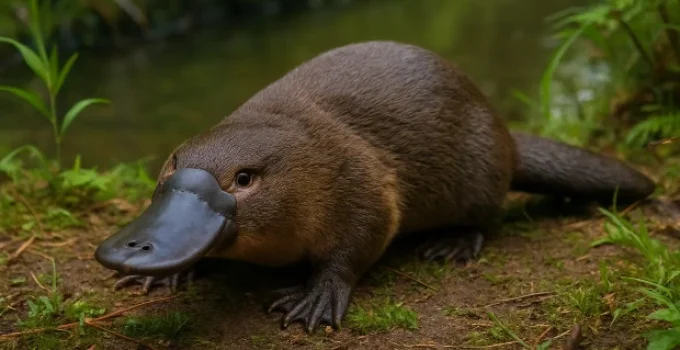⛏️Break It Down
- Which Mammals Lay Eggs?
- What Are Monotremes?
- Where Do Egg-Laying Mammals Live?
- How Do Monotremes Lay and Hatch Eggs?
- Do Monotremes Feed Their Babies Milk?
- Monotreme vs. Other Mammals Comparison Table
- 🎯 Final Thoughts
- 📚 References
Which Mammals Lay Eggs?
Only five mammals in the world lay eggs, and they all belong to a special group called monotremes. These rare mammals are the platypus and four species of echidnas, also known as spiny anteaters. Unlike most mammals, which give birth to live young, monotremes break the rules by hatching their babies from eggs.
Even though they lay eggs, these animals are still considered true mammals because they have fur, are warm-blooded, and produce milk for their young.
❓ Did You Know? The male platypus is venomous? According to National Geographic, their venom is located in a spur in the heel of the males.
What Are Monotremes?
Monotremes are an ancient group of mammals that have reptile-like traits, like egg-laying, but still do all the things that make mammals unique.
The five egg-laying mammals are:
- Platypus (1 species)
- Short-beaked echidna (1 species)
- Long-beaked echidna (3 species)
All monotremes are found in Australia and New Guinea, and they’re some of the most unusual mammals on Earth.
🌍 According to the Australian Museum, monotremes diverged from other mammals about 166 million years ago.
Where Do Egg-Laying Mammals Live?
Monotremes are found only in Australia and New Guinea:
- Platypus: Lives in freshwater streams and rivers in eastern Australia and Tasmania
- Short-beaked echidna: Found all across Australia and parts of Papua New Guinea
- Long-beaked echidnas: Found only in New Guinea’s tropical forests
Their habitats are usually moist and covered in vegetation, which helps protect their eggs and burrows.
🌿 According to South Australia’s Department of Environment and Water, echidnas are toothless, instead they use their 15 centimeter long, sticky tongue to slurp up ants, worms and insect larvae.
How Do Monotremes Lay and Hatch Eggs?
Unlike birds or reptiles, monotremes lay soft-shelled eggs, similar to those of snakes. Here’s how their egg-laying works:
- The platypus lays 1–3 eggs and incubates them in a burrow for about 10 days
- The echidna lays a single egg, which it places directly into a pouch on its belly
- The egg hatches after about 10 days, and the baby (called a puggle) is tiny and helpless
- The mother keeps the puggle warm and feeds it with milk
🐣 According to Ripley’s Believe It or Not, a baby platypus hatches blind, hairless, and only about the size of a jellybean!
Do Monotremes Feed Their Babies Milk?
Yes! Monotremes do not have nipples, but they still produce milk. Instead of nursing in the way most mammals do, monotreme mothers secrete milk through pores in their skin. The milk collects on special areas of the body where the baby can lap it up.
This unusual feeding method still gives the baby all the nutrients and antibodies it needs to grow strong and healthy.
🍼 Researchers recently discovered that monotreme milk contains special proteins not found in other mammals, which may help fight disease.
Monotreme vs. Other Mammals Comparison Table
| Trait | Monotremes (Egg-Laying) | Marsupials & Placentals (Live-Bearing) |
|---|---|---|
| Birth method | Lay eggs | Give birth to live young |
| Number of species | 5 species | Over 6,000 species |
| Milk production | Yes, no nipples | Yes, with nipples |
| Fur | Yes | Yes |
| Warm-blooded | Yes | Yes |
| Found in | Australia & New Guinea | All over the world |
🎯 Final Thoughts
Which mammals lay eggs? Only five unique species: the platypus and four types of echidnas. These egg-laying mammals are called monotremes, and they are living examples of ancient mammal evolution. Even though they break the mold, they still have all the key features of mammals—fur, milk, and warm blood. Nature always has room for a few rule-breakers!
📚 References
💻National Geographic. “How the Venomous, Egg-Laying Platypus Evolved.” https://www.nationalgeographic.com/animals/article/animals-platypus-evolution-science
💻Australian Museum. “The Evolution of the Platypus.” https://australian.museum/learn/teachers/learning/platypus-evolution/
💻South Australia’s Department of Environment and Water. “Echidnas.” https://www.environment.sa.gov.au/goodliving/posts/2019/01/echidna-facts
💻Ripley’s Believe It or Not. “On Becomin a Platypus Mom: Biting, Dancing, and… Oozing” https://www.ripleys.com/stories/platypus-moms
📝Newman, Janet, et al. “Structural Characterization of a Novel Monotreme-specific Protein With Antimicrobial Activity From the Milk of the Platypus.” Acta Crystallographica Section F Structural Biology Communications, vol. 74, no. 1, Dec. 2017, pp. 39–45. https://doi.org/10.1107/s2053230x17017708.
📌Learn More About Mammals
- When Do Squirrels Hibernate? 🐿️How These Smart Survivors Outsmart Winter
- What Makes an Animal a Mammal? 🐾 The Traits That Set Mammals Apart
- Do All Mammals Have Fur? 🦭 The Fuzzy Facts Behind Mammal Life
- What Does Warm-Blooded Mean? 🌡️ Animals That Bring the Heat (Literally)
- Do Marine Mammals Breathe Underwater? 🐬 Explore How They Survive in the Sea
